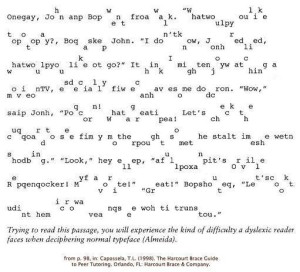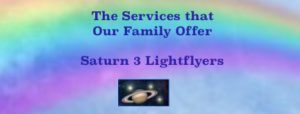
Learning to Read with Ease
by
Janiece L. Boardway, M.A.
Saturn3lightflyers.com
Tristan said the posted picture was very close to what he was seeing when he began learning to read. He added that the letters and words were dancing quite lively on the page and were never standing still. We started experimenting using books with different colored backgrounds and colored print, and Tristan said that the letters and words were no longer dancing around on the page, and thus, he could read.
We took him to a drugstore and asked him to pick out some sunglasses with colored lenses that he thought would work for him. Tristan chose lavender. We returned home, and he got one of his books that had black print on a white page, and Tristan said that he was able to see the letters and words clearly since they were no longer dancing around on the page. Tristan used the lavender-colored glasses on and off for a year or so, and after a while, he did not require them at all while reading — even black print on white paper.
We wondered, hmm, why is this? Wouldn’t you know it the next weekend, I met a woman who left her public teaching career, out of frustration, to assist children who were diagnosed. I immediately liked this woman. She told me that ever since schools stopped using the mimeograph machines in the late 1960s, the incidence and diagnoses of learning disorders, dyslexia, reading problems, etc., increased substantially. The woman went on to explain that it was at this time that schools went from using mimeograph machines that used paper, which was off-white with a more blue print to using photocopy machines with stark white paper and black print. Hence, the extreme contrast creates visual distortions such as shadows, movement in letters/numbers, which can result in headaches, problems with vision, attention, concentration as well as even being unable to track what line of text a person is reading.
We have suggested using colored lens glasses to many parents with children who have been struggling in school with reading, and it has worked. One 17-year-old teen, who was in special education and could not read, choose glasses with yellow lenses. When he returned home, he put on those yellow-tinted sun classes and began learning how to read with a lot more ease. His teacher and assistant could not believe it. He started writing stories, along with drawing vivid pictures of his flights in the cosmos he experienced during dreamtime. Quite amazing.
Now we are not saying that this simple technique will work for everyone; however, why not give it a try. Of course, it is always essential to have their eyes checked, which we did with Tristan, first to rule out anything that could be causing problems. For example, we found out that Tristan had tracking problems, and we did many exercises assigned to him to remedy that issue. Again, it is always important to have their eyes checked by a professional in that field.


